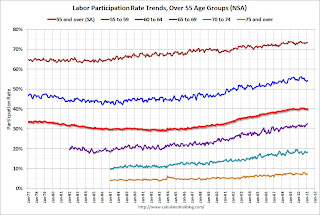by Calculated Risk on 3/04/2011 03:54:00 PM
Friday, March 04, 2011
Participation Rate Update
Last year I looked at some of the cyclical and long term trends for the participation rate: Labor Force Participation Rate: What will happen?. I concluded that most of the decline in the participation rate is due to changes in demographics - not cyclical. I also noted that it is possible that long term trends, especially more older workers participating in the labor force, combined with some cyclical improvement, could push the participation rate up a little over the next few years, and then the participation rate would start declining again.
What happens to the participation rate is an important question. If the Civilian noninstitutional population (over 16 years old) grows by about 2 million per year - and the participation rate stays flat - the economy will need to add about 100 thousand jobs per month to keep the unemployment rate steady at 8.9%.
If the population grows faster (say 2.5 million per year), and/or the participation rate rises, it could take significantly more jobs per month to hold the unemployment rate steady. As an example, if the working age population grows 2.5 million per year and the participation rate rises to 65% (from 64.2%) over the next two years, the economy will need to add 200 thousand jobs per month to hold the unemployment rate steady.
That is why forecasting the participation rate is important - and why reports of the number of jobs needed to hold the unemployment rate steady are all over the place (and can be very confusing - and I'm guilty of using different numbers).
Here is a look at some the long term trends (updating graphs through February 2011):
 Click on graph for larger image in graph gallery.
Click on graph for larger image in graph gallery.
This graph shows the changes in the participation rates for men and women since 1960 (in the 25 to 54 age group - the prime working years).
The participation rate for women increased significantly from the mid 30s to the mid 70s and has mostly flattened out. The participation rate for men has decreased from the high 90s to 88.8% in February 2011. (up slightly from January)
There will probably be some "bounce back" for both men and women (some of the recent decline is probably cyclical), but the long term trend for men is down.
 This graph shows that participation rates for several key age groups.
This graph shows that participation rates for several key age groups.
There are a few key long term trends:
• The participation rate for the '16 to 19' age group has been falling for some time (red). This fell to a record low 33.5% in February.
• The participation rate for the 'over 55' age group has been rising since the mid '90s (purple), although this has stalled out a little recently (perhaps cyclical).
• The participation rate for the '20 to 24' age group fell recently too (perhaps more education before joining the labor force). I expect the sharp decline over the last couple of years to turn around quickly as the job market improves.
 The third graph shows the participation rate for several over 55 age groups. The red line is the '55 and over' total seasonally adjusted. All of the other age groups are Not Seasonally Adjusted (NSA).
The third graph shows the participation rate for several over 55 age groups. The red line is the '55 and over' total seasonally adjusted. All of the other age groups are Not Seasonally Adjusted (NSA).
The participation rate is generally trending up for all older age groups. And this might push the overall participation rate up over the next 5 years. After that the 'over 55' participation rate will probably start to decline as the oldest baby boomers move into even older age groups.
I've been expecting some small bounce back in the participation rate, but my guess last year was probably too high. I know some analysts who think that it will just stay flat for a few years before declining again. This will be a key number to watch over the next few years.
Here are the earlier employment posts (with graphs):
• February Employment Report: 192,000 Jobs, 8.9% Unemployment Rate
• Employment Summary and Part Time Workers, Unemployed over 26 Weeks
• Duration of Unemployment, Unemployment by Education, Diffusion Indexes
• Employment Graph Gallery


